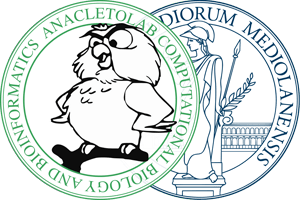
Giorgio Valentini
Full Professor
Email: giorgio (dot) valentini (at) unimi (dot) it
Master Degree in Biology and Computer Science, PhD in Computer Science (University of Genoa). Full Professor at the Department of Computer Science, University of Milan. Member of the UNIMI Doctoral School of Informatics and scientific director for UNIMI of the European PhD program in Genomics and Bioinformatics in collaboration with the Joint Research Center of the European Union. Research activity: development and application of Artificial Intelligence methods to bio-medical problems, with ongoing collaborations with various European and American research centers and universities including the Berlin Institute of Health, the Jackson Lab of Farmington (USA) and the S.Raffaele Hospital in Milano. Principal Investigator of 10 national and international projects in the area of Bioinformatics, Machine Learning and Big Data analysis. Member of the Editorial Board of Scientific Reports Nature. In 2018 one of his papers has been awarded as one of the best journal articles of the year by the International Medical Informatics Association. He is author of more than 140 scientific publications with peer-review in journals, book chapters and international conferences in the field of Machine Learning, Bioinformatics and Computational Biology.
Publications
L. Cappelletti, J. Gliozzo, A. Petrini and G. Valentini. Training Neural Networks with Balanced Mini-batch to Improve the Prediction of Pathogenic Genomic Variants in Mendelian Diseases. Sensors & Transducers, IFSA Publishing, SL 234(6), 2019.
M. Schubach, M. Re, P. Robinson and G. Valentini. Imbalance-aware machine learning for predicting rare and common disease-associated non-coding variants. Scientific reports, Nature Publishing Group 7(1), 2017.
M. Schubach, M. Re, P. Robinson and G. Valentini. Variant relevance prediction in extremely imbalanced training sets. F1000Research 6, 2017.
A. Petrini, M. Schubach, M. Re, M. Frasca, M. Mesiti, G. Grossi, T. Castrignanò, P. Robinson and G. Valentini. Parameters tuning boosts HyperSMURF predictions of rare deleterious non-coding genetic variants. PeerJ Preprints, PeerJ Inc. San Francisco, USA 5, 2017.
J. Gliozzo, P. Perlasca, M. Mesiti, E. Casiraghi, V. Vallacchi, E. Vergani, M. Frasca, G. Grossi, A. Petrini, M. Re, A. Paccanaro and G. Valentini. Network modeling of patients’ biomolecular profiles for clinical phenotype/outcome prediction. Scientific Reports, Nature Publishing, 2020.
G. Valentini, G. Armano, M. Frasca, J. Lin, M. Mesiti and M. Re. RANKS: a flexible tool for node label ranking and classification in biological networks. Bioinformatics, Oxford University Press 32(18), 2016.
M. Re, M. Mesiti and G. Valentini. An automated pipeline for multi-species protein function prediction from the UniProt Knowledgebase. Automated Function Prediction SIG-ISMB, 2014.
M. Re, M. Mesiti and G. Valentini. A fast ranking algorithm for predicting gene functions in biomolecular networks. IEEE/ACM Transactions on Computational Biology and Bioinformatics (TCBB), IEEE Computer Society Press 9(6), 2012.
M. Re and G. Valentini. Network-based drug ranking and repositioning with respect to DrugBank therapeutic categories. IEEE/ACM Transactions on Computational Biology and Bioinformatics, IEEE 10(6), 2013.
M. Re and G. Valentini. Large scale ranking and repositioning of drugs with respect to DrugBank therapeutic categories. International Symposium on Bioinformatics Research and Applications, 2012.
G. Valentini, A. Paccanaro, H. Caniza, A. Romero and M. Re. An extensive analysis of disease-gene associations using network integration and fast kernel-based gene prioritization methods. Artificial Intelligence in Medicine, Elsevier 61(2), 2014.
M. Re and G. Valentini. Cancer module genes ranking using kernelized score functions. BMC Bioinformatics, BioMed Central 13(14), 2012.
M. Re and G. Valentini. Random walking on functional interaction networks to rank genes involved in cancer. IFIP International Conference on Artificial Intelligence Applications and Innovations, 2012.
M. Re and G. Valentini. Genes prioritization with respect to Cancer Gene Modules using functional interaction network data.. NETTAB 2011 Workshop on Clinical Bioinformatics, 2011.
P. Perlasca, M. Frasca, C. Ba, M. Notaro, A. Petrini, E. Casiraghi, G. Grossi, J. Gliozzo, G. Valentini and M. Mesiti. UNIPred-Web: a web tool for the integration and visualization of biomolecular networks for protein function prediction. BMC Bioinformatics, BioMed Central 20(1), 2019.
M. Frasca, G. Grossi and G. Valentini. Multitask Hopfield Networks. European Conference on Machine Learning and Principles and Practice of Knowledge Discovery in Databases, , Wurzburg (Germany), 2019.
M. Frasca and G. Valentini. COSNet: An R package for label prediction in unbalanced biological networks. Neurocomputing, Elsevier 237, 2017.
P. Perlasca, G. Valentini, M. Frasca and M. Mesiti. Multi-species protein function prediction: towards web-based visual analytics.. iiWAS, 2016.
M. Frasca, A. Bertoni and G. Valentini. UNIPred: Unbalance-aware Network Integration and Prediction of protein functions. Journal of Computational Biology, Mary Ann Liebert, Inc. 140 Huguenot Street, 3rd Floor New Rochelle, NY 10801 USA 22(12), 2015.
M. Frasca, A. Bertoni, M. Re and G. Valentini. A neural network algorithm for semi-supervised node label learning from unbalanced data. Neural Networks, Elsevier 43, 2013.
M. Frasca, A. Bertoni and G. Valentini. An unbalance-aware network integration method for gene function prediction. MLSB 2013-Machine Learning for Systems Biology, 2013.
A. Bertoni, M. Frasca and G. Valentini. COSNet: a cost sensitive neural network for semi-supervised learning in graphs. Joint European Conference on Machine Learning and Knowledge Discovery in Databases, 2011.
M. Frasca, G. Grossi, J. Gliozzo, M. Mesiti, M. Notaro, P. Perlasca, A. Petrini and G. Valentini. A GPU-based algorithm for fast node label learning in large and unbalanced biomolecular networks. BMC Bioinformatics, BioMed Central 19(10), 2018.
J. Lin, M. Mesiti, M. Re and G. Valentini. Within network learning on big graphs using secondary memory-based random walk kernels. International Workshop on Complex Networks and their Applications, 2016.
M. Mesiti, M. Re and G. Valentini. Think globally and solve locally: secondary memory-based network learning for automated multi-species function prediction. GigaScience, BioMed Central 3(1), 2014.
M. Mesiti, M. Re and G. Valentini. Scalable network-based learning methods for automated function prediction based on the neo4j graph-database. Proceedings of the Automated Function Prediction SIG 2013—ISMB Special Interest Group Meeting, 2013.
N. Zhou, Y. Jiang, [...], M. Frasca, M. Notaro, G. Grossi, A. Petrini, M. Re, G. Valentini, M. Mesiti and others. The CAFA challenge reports improved protein function prediction and new functional annotations for hundreds of genes through experimental screens. Genome Biology 20(1), 2019.
M. Notaro, M. Schubach, M. Frasca, M. Mesiti, P. Robinson and G. Valentini. Ensembling descendant term classifiers to improve gene-abnormal phenotype predictions. International Meeting on Computational Intelligence Methods for Bioinformatics and Biostatistics, 2017.
M. Notaro, M. Schubach, P. Robinson and G. Valentini. Prediction of Human Phenotype Ontology terms by means of hierarchical ensemble methods. BMC Bioinformatics, BioMed Central 18(1), 2017.
P. Robinson, M. Frasca, S. Köhler, M. Notaro, M. Re and G. Valentini. A hierarchical ensemble method for dag-structured taxonomies. International Workshop on Multiple Classifier Systems, 2015.
G. Valentini, S. Köhler, M. Re, M. Notaro and P. Robinson. Prediction of human gene-phenotype associations by exploiting the hierarchical structure of the human phenotype ontology. International Conference on Bioinformatics and Biomedical Engineering, 2015.
G. Valentini. Hierarchical ensemble methods for protein function prediction. ISRN Bioinformatics, Hindawi Publishing Corporation 2014, 2014.
N. Cesa-Bianchi, M. Re and G. Valentini. Synergy of multi-label hierarchical ensembles, data fusion, and cost-sensitive methods for gene functional inference. Machine Learning, Springer 88(1-2), 2012.
G. Valentini. True path rule hierarchical ensembles for genome-wide gene function prediction. IEEE/ACM Transactions on Computational Biology and Bioinformatics, IEEE 8(3), 2010.
N. Cesa-Bianchi and G. Valentini. Hierarchical cost-sensitive algorithms for genome-wide gene function prediction. Machine Learning in Systems Biology, 2009.
M. Re and G. Valentini. An experimental comparison of Hierarchical Bayes and True Path Rule ensembles for protein function prediction. International Workshop on Multiple Classifier Systems, 2010.
N. Cesa-Bianchi, M. Re and G. Valentini. Functional inference in FunCat through the combination of hierarchical ensembles with data fusion methods. ICML Workshop on learning from Multi-Label Data MLD'10, 2010.
G. Valentini. True path rule hierarchical ensembles. International Workshop on Multiple Classifier Systems, 2009.
A. Rozza, G. Lombardi, M. Re, E. Casiraghi, G. Valentini and P. Campadelli. A novel ensemble technique for protein subcellular location prediction. Ensembles in Machine Learning Applications, Springer, 2011.
A. Rozza, G. Lombardi, M. Re, E. Casiraghi and G. Valentini. DDAG K-TIPCAC: an ensemble method for protein subcellular localization. ECML SUEMA 2010 workshop: supervised and unsupervised ensemble methods and their applications, 2010.
M. Rè and G. Valentini. Noise tolerance of Multiple Classifier Systems in data integration-based gene function prediction. Journal of integrative bioinformatics, De Gruyter 7(3), 2010.
M. Re and G. Valentini. Simple ensemble methods are competitive with state-of-the-art data integration methods for gene function prediction.. MLSB, 2010.
M. Re and G. Valentini. Integration of heterogeneous data sources for gene function prediction using decision templates and ensembles of learning machines. Neurocomputing, Elsevier 73(7-9), 2010.
M. Re and G. Valentini. Ensemble based data fusion for gene function prediction. International Workshop on Multiple Classifier Systems, 2009.
A. Bertoni, R. Folgieri and G. Valentini. Bio-molecular cancer prediction with random subspace ensembles of support vector machines. Neurocomputing, Elsevier 63, 2005.
P. Campadelli, E. Casiraghi and G. Valentini. Support vector machines for candidate nodules classification. Neurocomputing, Elsevier 68, 2005.
A. Bertoni, R. Folgieri and G. Valentini. Feature selection combined with random subspace ensemble for gene expression based diagnosis of malignancies. Biological and Artificial Intelligence Environments, Springer, 2005.
G. Valentini, M. Muselli and F. Ruffino. Cancer recognition with bagged ensembles of support vector machines. Neurocomputing, Elsevier 56, 2004.
G. Valentini. An application of low bias bagged SVMs to the classification of heterogeneous malignant tissues. Italian Workshop on Neural Nets, 2003.
G. Valentini, M. Muselli and F. Ruffino. Bagged ensembles of support vector machines for gene expression data analysis. Proceedings of the International Joint Conference on Neural Networks, 2003. 3, 2003.
G. Valentini. Gene expression data analysis of human lymphoma using support vector machines and output coding ensembles. Artificial Intelligence in Medicine, Elsevier 26(3), 2002.
G. Valentini. Supervised gene expression data analysis using Support Vector Machines and Multi-Layer perceptrons. Proc. of KES’2002, the Sixth International Conference on Knowledge-Based Intelligent Information \& Engineering Systems, special session Machine Learning in Bioinformatics, 2002.
G. Valentini. Classification of human malignancies by machine learning methods using DNA microarray gene expression data. Fourth International Conference Neural Networks and Expert Systems in Medicine and HealthCare, 2001.
R. Avogadri and G. Valentini. Fuzzy ensemble clustering based on random projections for DNA microarray data analysis. Artificial Intelligence in Medicine, Elsevier 45(2-3), 2009.
A. Bertoni and G. Valentini. Discovering multi--level structures in bio-molecular data through the Bernstein inequality. BMC Bioinformatics, BioMed Central 9(2), 2008.
R. Avogadri and G. Valentini. Ensemble clustering with a fuzzy approach. Supervised and unsupervised ensemble methods and their applications, Springer, 2008.
A. Bertoni and G. Valentini. Model order selection for bio-molecular data clustering. BMC Bioinformatics, BioMed Central 8(2), 2007.
R. Avogadri and G. Valentini. Fuzzy ensemble clustering for DNA microarray data analysis. International Workshop on Fuzzy Logic and Applications, 2007.
A. Bertoni and G. Valentini. Randomized maps for assessing the reliability of patients clusters in DNA microarray data analyses. Artificial Intelligence in Medicine, Elsevier 37(2), 2006.
A. Bertoni and G. Valentini. Model order selection for clustered bio-molecular data. Probabilistic Modeling and Machine Learning in Structural and Systems Biology Workshop, 2006.
G. Valentini. Mosclust: a software library for discovering significant structures in bio-molecular data. Bioinformatics, Oxford University Press 23(3), 2006.
A. Bertoni and G. Valentini. Random projections for assessing gene expression cluster stability. Proceedings. 2005 IEEE International Joint Conference on Neural Networks, 2005. 1, 2005.
G. Valentini. Clusterv: a tool for assessing the reliability of clusters discovered in DNA microarray data. Bioinformatics, Oxford University Press 22(3), 2005.
G. Valentini and F. Ruffino. Characterization of lung tumor subtypes through gene expression cluster validity assessment. RAIRO-Theoretical Informatics and Applications, EDP Sciences 40(2), 2006.
R. Avogadri, M. Brioschi, F. Ferrazzi, M. Re, A. Beghini and G. Valentini. A stability-based algorithm to validate hierarchical clusters of genes. International Journal of Knowledge Engineering and Soft Data Paradigms, Inderscience Publishers 1(4), 2009.
R. Avogadri, M. Brioschi, F. Ruffino, F. Ferrazzi, A. Beghini and G. Valentini. An algorithm to assess the reliability of hierarchical clusters in gene expression data. International Conference on Knowledge-Based and Intelligent Information and Engineering Systems, 2008.
M. Frasca, S. Bassis and G. Valentini. Learning node labels with multi-category hopfield networks. Neural Computing and Applications, Springer 27(6), 2016.
M. Frasca, A. Bertoni and G. Valentini. A cost-sensitive neural algorithm to predict gene functions using large biological networks. Network Biology SIG: On the Analysis and Visualization of Networks in Biology, 2011.
M. Muselli, A. Bertoni, M. Frasca, A. Beghini, F. Ruffino and G. Valentini. A mathematical model for the validation of gene selection methods. IEEE/ACM transactions on computational biology and bioinformatics, IEEE 8(5), 2010.
A. Cuzzocrea, L. Cappelletti and G. Valentini. A neural model for the prediction of pathogenic genomic variants in Mendelian diseases. Proceedings of the 1st International Conference on Advances in Signal Processing and Artificial Intelligence (ASPAI'19), Barcelona, Spain, 2019.
R. Avogadri and G. Valentini. An unsupervised fuzzy ensemble algorithmic scheme for gene expression data analysis. NETTAB 2007 workshop on a Semantic Web for Bioinformatics, 2007.
G. Pavesi and G. Valentini. Classification of co-expressed genes from DNA regulatory regions. Information Fusion, Elsevier 10(3), 2009.
M. Re, M. Mesiti and G. Valentini. Comparison of early and late omics data integration for cancer modules gene ranking. NETTAB: Integrated Bio-Search, 2012.
G. Valentini, R. Tagliaferri and F. Masulli. Computational intelligence and machine learning in bioinformatics. Elsevier, 2009.
A. Bertoni and G. Valentini. Discovering significant structures in clustered bio-molecular data through the bernstein inequality. International Conference on Knowledge-Based and Intelligent Information and Engineering Systems, 2007.
M. Re, M. Mesiti and G. Valentini. Drug repositioning through pharmacological spaces integration based on networks projections. EMBnet. journal 18(A), 2012.
A. Bertoni and G. Valentini. Ensembles based on random projections to improve the accuracy of clustering algorithms. Neural nets, Springer, 2005.
O. Okun, G. Valentini and H. Priisalu. Exploring the link between bolstered classification error and dataset complexity for gene expression based cancer classification. New Signal Processing Research, Nova Publishers, 2009.
F. Ruffino, M. Muselli and G. Valentini. Gene expression modeling through positive Boolean functions. International journal of approximate reasoning, Elsevier 47(1), 2008.
H. Vierci, A. Romero, S. Heron, H. Yang, M. Frasca, M. Mesiti, G. Valentini and A. Paccanaro. GOssTo \& GOssToWeb: user-friendly tools for calculating semantic simi-larities on the Gene Ontology. Bio-Ontologies SIG 2013-ISMB 2013, 2013.
H. Caniza, A. Romero, S. Heron, H. Yang, A. Devoto, M. Frasca, M. Mesiti, G. Valentini and A. Paccanaro. GOssTo: a stand-alone application and a web tool for calculating semantic similarities on the Gene Ontology. Bioinformatics, Oxford University Press 30(15), 2014.
G. Valentini and N. Cesa-Bianchi. Hcgene: a software tool to support the hierarchical classification of genes. Bioinformatics, Oxford University Press 24(5), 2008.
A. Bertoni, M. Re, F. Saccà and G. Valentini. Identification of promoter regions in genomic sequences by 1-dimensional constraint clustering.. WIRN, 2011.
G. Valentini, A. Paccanaro, H. Vierci, A. Romero and M. Re. Network integration boosts disease gene prioritization. Network Biology SIG, 2013.
M. Re and G. Valentini. Predicting gene expression from heterogeneous data. International Meeting on Computational Intelligence Methods for Bioinformatics and Biostatistics (CIBB), 2009.
M. Re and G. Valentini. Prediction of gene function using ensembles of SVMs and heterogeneous data sources. Applications of supervised and unsupervised ensemble methods, Springer, 2009.
S. Vascon, M. Frasca, R. Tripodi, G. Valentini and M. Pelillo. Protein function prediction as a graph-transduction game. Pattern Recognition Letters, Elsevier, 2018.
A. Bertoni and G. Valentini. Randomized embedding cluster ensembles for gene expression data analysis. SETIT 2007-IEEE International Conf. on Sciences of Electronic, Technologies of Information and Telecommunications, 2007.
A. Beghini, F. Corlazzoli, L. Del Giacco, M. Re, F. Lazzaroni, M. Brioschi, G. Valentini, F. Ferrazzi, A. Ghilardi, M. Righi and Others. Regeneration-associated WNT signaling is activated in long-term reconstituting AC133bright acute myeloid leukemia cells. Neoplasia (New York, NY), Neoplasia Press 14(12), 2012.
M. Frasca, A. Bertoni and G. Valentini. Regularized network-based algorithm for predicting gene functions with high-imbalanced data. EMBnet. journal 18(A), 2012.
H. Su, G. Valentini, S. Szedmak and J. Rousu. Transport protein classification through structured prediction and multiple lernel learning. NIPS Workshop on Machine Learning in Computational Biology (MLCB) \& Machine Learning in Systems Biology (MLSB), 2015.
A. Bertoni and G. Valentini. Unsupervised stability-based ensembles to discover reliable structures in complex bio-molecular data. International Meeting on Computational Intelligence Methods for Bioinformatics and Biostatistics, 2008.
G. Valentini and M. Re. Weighted True Path Rule: a multilabel hierarchical algorithm for gene function prediction. European Conference on Machine Learning and Principles and Practice of Knowledge Discovery in Databases: 1st International Workshop on learning from Multi-Label Data, 2009.
M. Mesiti, E. Jimènez-Ruiz, I. Sanz, R. Berlanga-Llavori, P. Perlasca, G. Valentini and D. Manset. XML-based approaches for the integration of heterogeneous bio-molecular data. BMC Bioinformatics, BioMed Central 10(12), 2009.
L. Cappelletti, T. Fontana, G. Donato, L. Tucci, E. Casiraghi and G. Valentini. Complex Data Imputation by Auto-Encoders and Convolutional Neural Networks—A Case Study on Genome Gap-Filling. Computers, Multidisciplinary Digital Publishing Institute 9(2), 2020.
M. Frasca, J. Fontaine, G. Valentini, M. Mesiti, M. Notaro, D. Malchiodi and M. Andrade-Navarro. Disease--Genes must Guide Data Source Integration in the Gene Prioritization Process. International Meeting on Computational Intelligence Methods for Bioinformatics and Biostatistics, 2017.
L. Cappelletti, A. Petrini, J. Gliozzo, E. Casiraghi, M. Schubach, M. Kircher and G. Valentini. Bayesian optimization improves tissue-specific prediction of active regulatory regions with deep neural networks. International Work-Conference on Bioinformatics and Biomedical Engineering, 2020.
S. Vascon, M. Frasca, R. Tripodi, G. Valentini and M. Pelillo. Protein function prediction as a graph-transduction game. Pattern Recognition Letters, Elsevier 134, 2020.
M. Frasca, M. Sepehri, A. Petrini, G. Grossi and G. Valentini. Committee-Based Active Learning to Select Negative Examples for Predicting Protein Functions. International Meeting on Computational Intelligence Methods for Bioinformatics and Biostatistics, 2018.
 AnacletoLAB
AnacletoLAB


